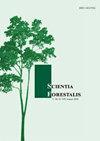水分和有效成分浓度对CCA-C保留率的影响
IF 0.4
4区 农林科学
Q4 FORESTRY
引用次数: 0
摘要
木材防腐处理公司的策略是控制影响保留率的因素,如防腐剂溶液的浓度和木材水分,使其达到更高的值,更接近最低标准。本研究的目的是在不影响处理质量的情况下,通过确定不同活性成分浓度下两种基因型桉树的最有效木材水分间隔,减少C型铬酸铜(CCA-C)的消耗。对54根栅栏桩进行了处理,分别为cloeziana和camaldulensis x urophylla杂交种。这些碎片是随机从三个不同储存时间的干燥堆中选择的(长、中、短)。所测有效成分浓度分别为1.2、1.4、1.6%。通过保留分析来评价防腐处理的质量。两种材料在短桩和长桩、浓度分别为1.2%和1.6% A.I. CCA-C时的平均保留值最低,平均保留值最高。对于cloeziana,根据巴西标准,只有储存时间较长且CCA-C用量为1.6%的柱适合与土壤接触,而对于无性系杂交种,储存时间较长且CCA-C用量为1.6%的柱适合与土壤接触。结果表明,保鲜液中有效成分的浓度和物料在院子里的存放时间直接影响了篱笆桩中CCA-C的保留率。本文章由计算机程序翻译,如有差异,请以英文原文为准。
Effect of moisture and active ingredient concentration on CCA-C retention
The strategy of wood preservative treatment companies is to control the factors that influence retention, such as the concentration of the preservative solution and wood moisture, to reach values higher and closer to the standard minimum. The objective of this study was to reduce the consumption of Chromated Copper Arsenate type C (CCA-C) without affecting the quality of the treatment by determining the most efficient wood moisture interval for two genotypes of Eucalyptus sp. at different concentrations of active ingredients. A total of 54 fence posts of the species E. cloeziana and the hybrid E. camaldulensis x E. urophylla were treated. The pieces were randomly selected from three drying piles with different storage times in the yard (long, intermediate, and short). The active ingredient concentrations tested were 1.2, 1.4, and 1.6%. Retention analysis was performed to evaluate the quality of the preservative treatment. For both analyzed materials, the lowest and highest average retention values were observed in short and long storage piles and concentrations of 1.2% and 1.6% A.I. CCA-C, respectively. For E. cloeziana , only posts with a long storage time and treated with 1.6% of CCA-C were considered suitable for use in contact with the soil, according to the Brazilian standard, while for the clonal hybrid, posts with intermediate and long storage times, treated with 1.6% of CCA-C were considered suitable for use in contact with the soil. It was observed that CCA-C retention in the studied fence posts was directly influenced by the concentration of active ingredient in the preservative solution and by the storage time of the materials in the yard.
求助全文
通过发布文献求助,成功后即可免费获取论文全文。
去求助
来源期刊

Scientia Forestalis
Agricultural and Biological Sciences-Forestry
CiteScore
1.00
自引率
0.00%
发文量
39
期刊介绍:
Scientia Forestalis is a scientific publication of the IPEF – Institute of Forest Research and Studies, founded in 1968, as a nonprofit institution, in agreement with the LCF – Department of Forest Sciences of the ESALQ – Luiz de Queiroz College of Agriculture of the USP – São Paulo University. Scientia Forestalis, affiliated to the ABEC – Brazilian Association of Scientific Publishers, publishes four issues per year of original papers related to the several fields of the Forest Sciences.
The Editorial Board is composed by the Editor, the Scientific Editors (evaluating the manuscript), and the Associated Editors (helping on the decision of acceptation or not of the manuscript, analyzed by the Peer-Reviewers.
 求助内容:
求助内容: 应助结果提醒方式:
应助结果提醒方式:


